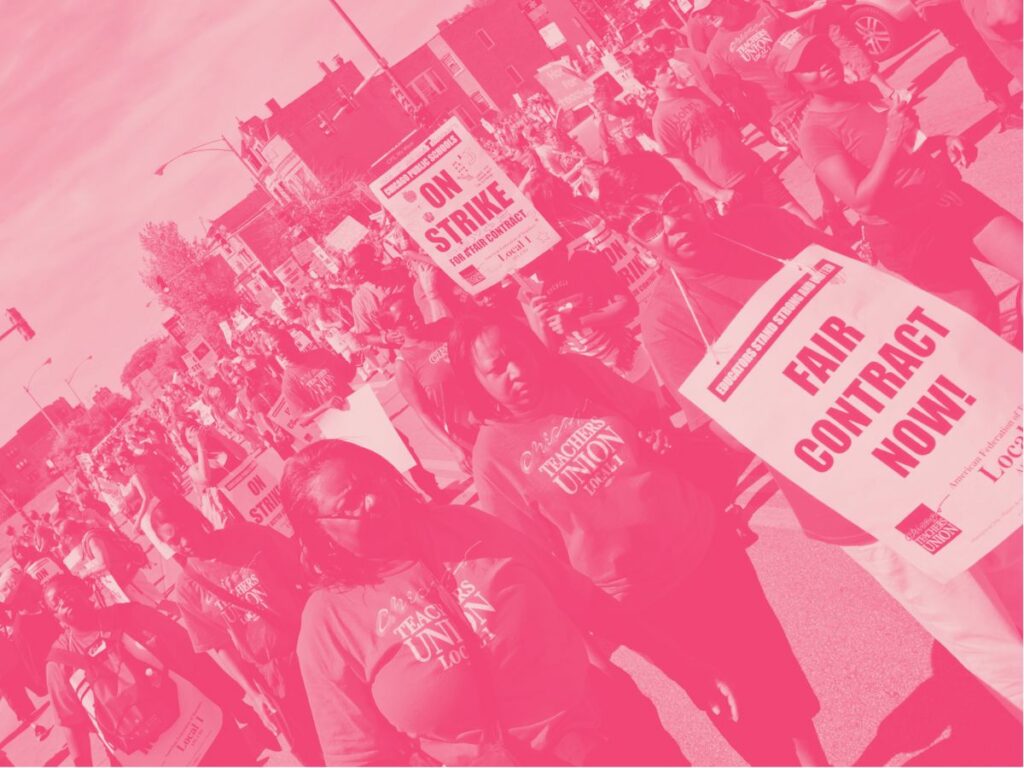The historic Chicago Teachers Union strike in 2012 marked a flashpoint in organizing history that ignited Chicago laborers—and as a community organizer, I witnessed the way the CTU inspired people all over the city to stand up for their rights in imaginative ways, creating a wave of possibilities that lifted all boats, including the Fight for $15.
Under the Caucus of Rank-and-File Educators (CORE), the CTU foregrounded the integral connection between working and living conditions. There are always earthquakes before a tidal wave, and the earthquakes that propelled CORE began years before the picket lines formed. Inside the classroom, quakes of education reform rocked the Chicago Public Schools (CPS). The “Renaissance 2010” plan was championed by corporate interests to privatize education. The practice of stifling workers’ voices, ignoring customer complaints, and making money by keeping overhead low and creating a monopoly shook Chicago, diverting public dollars to corporate-driven, public-in-name-only charter schools. The school funding model, linked to property taxes and mayoral control, left low-income black and brown traditional public schools to crumble. As charter and selective enrollment schools were getting the latest computers and iPads, low-income black and brown schools had to have fundraising drives for basic needs like books and toilet paper.
Meanwhile, outside of the classroom, black and brown communities in Chicago were experiencing the aftershock of decades of destabilization. Chicago remains a segregated city where your zip code can shape your life expectancy, so when CPS ran through its first wave of school closures, parents and teachers alike experienced the realities of that shift. Many parents in low-income communities, already scrambled by low wages, housing instability, and traumatic violence, were spread too thin to be saddled with the aftermath of school closings. Children caught in rough conditions at home were met with harsh conditions at school, with no school counselors, no arts education, and limited outlets for their social and emotional well-being.
New CTU linked school and neighborhood
The dissonance between what CPS was offering – budget cuts, overcrowded classrooms, increased standardized testing – and the dedication to the education of children and the living conditions of students that impacted their learning conditions inspired teachers and paraprofessionals to organize and fight back. CORE began organizing inside and outside the school, partnering with grassroots, community-based organizations like Action Now, Kenwood Oakland Community Organization, and many others to build relationships, train their cadre on community organizing, and build power to transform education instead of just reforming it.
After CORE members won union leadership in 2010, they worked to make their vision a reality. The new CTU had an integral approach to education – if anything mattered, then everything mattered–so they took stances on various social issues that impacted student learning. They created the visionary document, “The Schools Chicago Students Deserve,” positioning themselves with bold statements on everything from arts education to racial segregation. They worked with local community organizations to build deeper relationships between teachers and parents, supporting first-year teachers to do door knocking and home visits in their classrooms’ communities. They supported community-led initiatives like the Chicago Vacant Property Ordinance, designed to secure vacant buildings near schools to reduce blight and havens for crime. And they took a stance on raising the minimum wage because they knew that it would be a game changer for their students if their parents could make a living wage.
I was an organizer at Action Now back when CORE first came into power. I was working to support education organizing through the Grow Your Own Teachers program, recruiting people of color from the local communities into the teaching profession. Some of the teacher candidates were paraprofessionals in the school, so they had some opinions about the union, but they also lived in the neighborhoods, so they had a vested interest in neighborhood issues too.
We held community meetings in some schools, and the union leaders joined as community members. They shared that they were fighting for schools that served the needs of the children and showed up as authentic neighbors because they also lived in the community. People like Christel Williams and Brandon Johnson sat with parents and community members to share their vision for schools. The community asked the tough questions about how any of that could be possible with a mayor like Rahm Emanuel. And Brandon said something like, “Well, it probably can’t, but we aren’t fighting just to beat Rahm; we’re fighting because these schools, our schools, and our children matter.” And that was something that the parents, grandparents, and other community leaders could get behind.
Teacher-community connection triumphs
By the time the strike happened, the community was ready. Grow Your Own Teachers candidates and Action Now members had created phone trees, mock lesson plans, food drop-offs, and other activities. Organizers across the city were ready to discuss the values behind the strike on the doors and in community meetings.
I lived across the street from an elementary school then, and I joined the picket line for a little while. If I had kids, that would have been my neighborhood elementary school. I spoke with teachers and paraprofessionals as they shared their anger and heartbreak at a system that bound them to tests instead of compassionate education. I remember one teacher who was surprised at how many parents and community members showed up to the school, saying there were more people out in support of the strike than on report card pick-up day. But I could see her eyes light up every time she paused her story to shriek with joy at the cars honking as they drove past, and I wondered if it was the first time she felt “seen.”
You could not help but see the CTU. The palpable mix of joy and power that flooded the streets with CTU red was unlike any experience in my life until that point. Everyone was watching Chicago. Chicagoans had no choice but to pay attention, and the messages from the CTU focused on real-life issues – lack of recess, lack of wrap-around services, and other issues that anyone who had any connection with traditional neighborhood schools knew were the truth.
Stephanie Gadlin, CTU’s press secretary at the time, was adept at crafting a compelling message and training people on the rigor needed to keep to the message. The CPS spin doctors could not keep up with her or Karen Lewis, whose charisma, wit, and brilliance are deeply missed. When the opposition would say things like, “This is just the teachers brokering for more money,” the community would say, “Yes! They deserve it”. It seemed like every time the mayor would try to dim CTU’s shine, the community’s support of the teachers would grow brighter.
The opposition could not shake the counterweight of the community-teacher connection. As the strike continued, some candidates within the Grow Your Own Teachers program set up “solidarity schools,” partnering with local businesses to hold space for kids with food and educational activities. We continued to have community meetings, and parents always asked me where they could get signs to show their support of the teachers. I remember picking up signs at the strike headquarters. If you’re old enough to remember the Doozers from Fraggle Rock, imagine that all that Doozers were wearing red, and you might be able to picture the dedication and energy that filled the space, with people laughing and yelling as they took on the monumental effort of keeping everything in motion for 30,000 folks. For eight days, the teachers and paraprofessionals at the CTU wrestled with Mayor Rahm Emanuel for the soul of public education. The community felt like the CTU was fighting for “us.”
While the strike did not win everything the teachers needed in their contract, it helped the CTU win the hearts and minds of millions of people. Systems don’t change unless the people in them change, and CTU changed people in a way that gave them hope that a better world could be possible if we would stand up and fight for it.
Before and after
We mark time by the CTU strike: The analog days before the strike, when few knew who the union was, and the digital days after the strike when everyone knew that Chicago was a union town. Meanwhile, low-wage workers, many of whom were the parents of the students the teachers were fighting for, were watching this union power flex in real-time. It was unheard of to hear a union take a stance on public policy issues that impacted the broader community. Many people had no direct experience with a union at all. The CTU strike leveled up and expanded the collective organizing consciousness and showed that power is the only thing that power understands, and power concedes nothing without a demand.
So, a few months after the strike, when fast-food workers picked up their picket signs and demanded $15 and a union, they had some supporters in red show up with them, too, with plenty of battle stories to share. While the fast-food workers have yet to win their union, the Fight for $15 changed the game, taking some cues from the CTU – focus on the issues that real-people matter, build broad relationships, and be clear about what you are fighting for.
Fight for $15, like the CTU strike, showed that there is no separation between work and life – the condition of one impacts the other. The Fight for $15 carried forward other aspects inspired by the CTU strike, in particular the integration of community support and labor relations. Regular everyday people showed up to support the fast-food strikes just like they had for the CTU, because they related to the humanity of fast-food workers and were appalled by the inhumanity of corporate greed. And just like the CTU strike, Fight for $15 showed us how much wages matter. Wages are not an arbitrary number assigned to a unit of labor, they are expressions of value, and worth is the value of something measured by the esteem in which it is held. We are all worth more. The Chicago Teachers Union strike, followed by the fast-food strikes of the Fight for $15, reminded everyone that there ain’t no power like the power of the people ‘cause the power of the people don’t stop. Say what?
Featured image: September 12th rally during the 2012 Chicago Teachers Union strike. Photo courtesy of Sarah-Ji (Love & Struggle Photos).
Did you enjoy this article?
We're in the middle of our annual fund drive, and this year we're building our own internal infrastructure for subscriptions, meaning more of every dollar pledged goes to fulfilling our mission. Subscribe today to support our work and be a part of Convergence's next evolution.

